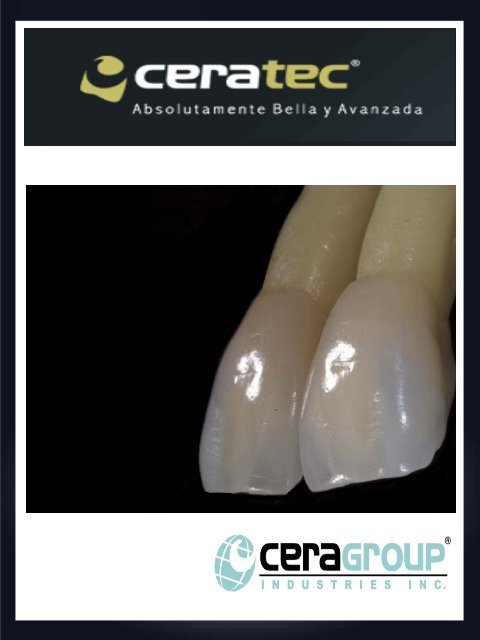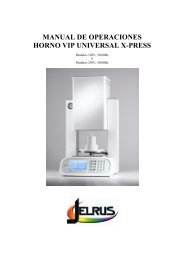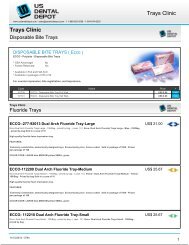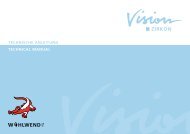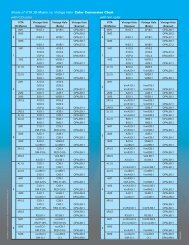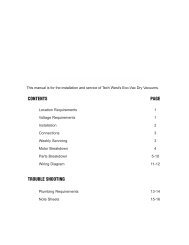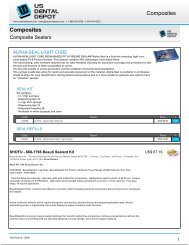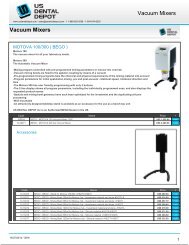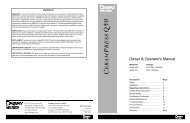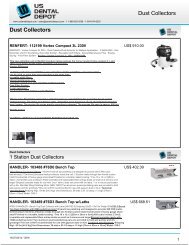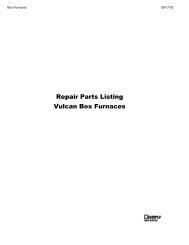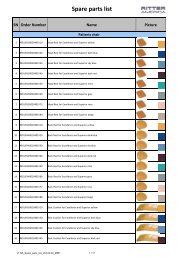Create successful ePaper yourself
Turn your PDF publications into a flip-book with our unique Google optimized e-Paper software.
CERATEC’S PORCELAIN SYSTEM<br />
TABLE OF CONTENTS<br />
TABLE OF CONTENTS…..................................................................11<br />
1 CHARACTERISTICS ....................................................................22<br />
INDICATIONS......……………………………………….………………………………………..33<br />
2 METALLIC FRAMEWORK .……………………………………….……………...............44<br />
THE ALLOY……….…………………………………………………….……………………………..55<br />
3 LAYERING DIAGRAM SIDE VIEW…………………………..……………………………..66<br />
LAYERING DIAGRAM FRONTAL VIEW……………………………………….…..……..7 7<br />
LAYERING REAL VIEW………………………………………………….……………………….88<br />
4 PRODUCT PRESENTATION………………………………………………………………..…..9 9<br />
5 CASE PRESENTATION………………………………………………………………………….…10<br />
MODEL AND DIE ……………………......................................................10<br />
METALLIC FRAMWORK .................................................................10<br />
6 TECHNIQUE………………..................................................................11<br />
METAL FINISHING……………….........................................................11<br />
OPAQUE APPLICATION…..............................................................11<br />
SHOULDER APPLICATION……………..….............................................12<br />
DENTINE BUILD UP……………………………….………………………………………..…...13<br />
INCISAL – ENAMEL BUILD UP……………………………………………………………….14<br />
POLISHING………………………………………………………………………………………....…15<br />
STAINING AND GLAZING…………….………………………………………………….…….16<br />
FINISHED RESTORATION………………………………………………………………….…..17<br />
7 TECHNICAL DATA .......................................................................18<br />
8 RELATIVE OPACITY CHART………………………………………………………………….…19<br />
9 COLOR COMBINATION CHART……………………………………………………………...20<br />
10 FIRING CHART ………………………………….....................................21, 22<br />
11 TROUBLE SHOOTING…………………….…………………………………………………...23<br />
1
CHARACTERISTICS<br />
Our ceramic is designed keeping one objective in mind:<br />
to easily replicate the beauty and vitality of natural teeth.<br />
• Fine grain natural feldspathic <strong>porcelain</strong><br />
• Great modeling ease, especially suitable for laboratories<br />
in which speed and accuracy are top priority.<br />
• Easy to use for the ceramist with little experience but with<br />
all of the properties and products necessary for the expert<br />
ceramist.<br />
• Immediate and accurate shade matching with the mere<br />
application of opaque/dentine/incisal layering; color<br />
stability even with varied thickness.<br />
• Extremely stable linear expansion coefficients during<br />
subsequent firing processes; safely withstands up to six<br />
firing cycles.<br />
• Minimum shrinkage.<br />
• Great translucency and color depth.<br />
• Opaque, Dentine, Chroma Dentine and Opacious Dentine<br />
available in all shades A0 – D4.<br />
• Wide color range of shoulder shades, opaque modifiers,<br />
dentine modifiers, incisals, enamels and stains.<br />
• “Live” and natural fluorescence in all light conditions.<br />
2
INDICATIONS<br />
CERATEC <strong>porcelain</strong> is the product to use for:<br />
- Porcelain fused to metal (PFM) crowns and bridges<br />
- Porcelain jacket crowns<br />
- Veneers<br />
- Inlays and Onlays<br />
The linear coefficient of thermal expansion of CERATEC is<br />
included in the interval 12,60-12,95 x 10-6 / ºC for all types of<br />
<strong>porcelain</strong> (opaque, dentines and incisals) measured in the range<br />
of 25-500ºC the lower value corresponds to the first firing and<br />
the higher value measured after the fourth cooking.<br />
The glass transition temperature is between 480 and 500 ºC for<br />
all of the <strong>porcelain</strong>s.<br />
3
METALLIC FRAMEWORK<br />
During model and die preparation, keep in mind that <strong>porcelain</strong><br />
fused to metal restorations require a minimum thickness of 1.5 to<br />
1.8 mm of which 0.3 to 0.5 mm is the metal portion. The model<br />
can be prepared using the desired technique. Remember that the<br />
use of shoulder <strong>porcelain</strong> requires a proper shoulder preparation.<br />
The modeling of the metallic framework can be performed with<br />
the desired technique. The space reserved for the ceramic<br />
covering should not be less than 0.8 mm. The ceramic layer<br />
should not exceed 2 mm in thickness on the incisal borders to<br />
avoid the risk of fractures.<br />
Avoid creating sharp corners, indentations, angles or curved<br />
edges on the metal surface that is to be covered. Every sharp<br />
corner is a potential point of origin for fractures, while every<br />
indentation could cause defects in the ceramic fusing process or<br />
fractures due to the contraction that occurs during firing.<br />
4
The Alloy<br />
In general, most of the alloys used for ceramic fused to metal<br />
restorations are compatible with CERATEC <strong>porcelain</strong>s. However,<br />
since every alloy reacts differently with respect to the coefficient of<br />
expansion and can sometimes be unpredictable beyond the<br />
officially published data, we suggest that you utilize the alloys<br />
recommended for the product with a CTE in the range of 13.8 –<br />
14.8 x 10-6/°C, measured in the range of 25 – 500°C.<br />
5
RECOMMENDED LAYERING<br />
Incisals<br />
Dentine<br />
Chroma<br />
Dentine<br />
Opacious Dentine<br />
Opaque<br />
Metallic<br />
Framework<br />
SEE COLOR COMBINATION CHART<br />
6
RECOMMENDED LAYERING<br />
Translucent<br />
Dentine modifier<br />
Incisal-Enamel<br />
Chroma Dentine<br />
Dentine<br />
Opacious Dentine<br />
SEE COLOR COMBINATION CHART<br />
7
RECOMMENDED LAYERING<br />
8
PRESENTATION<br />
Absolutely Beautiful<br />
9
CASE PRESENTATION<br />
Working Model<br />
Metallic Framework<br />
prepared for ceramic shoulder<br />
Frontal View<br />
Complete Case<br />
10
Metal finishing should be done<br />
with a carbide burr or diamond<br />
OPAQUE<br />
First opaque coat<br />
layering and firing<br />
Second opaque coat<br />
layering and firing<br />
Fired opaque<br />
11
Preparation of the ceramic shoulder<br />
First firing of the ceramic shoulder<br />
Second firing of the ceramic shoulder<br />
12
DENTINES<br />
Opacious Dentine<br />
Chroma Dentine<br />
Dentine<br />
Fired Dentines<br />
13
INCISALS AND ENAMELS<br />
Fired Dentines<br />
Incisal translucent<br />
Incisal modifier yellow<br />
Enamel 1 and 4<br />
Incisal modifier blue<br />
Incisal I-1<br />
Second Firing<br />
14
POLISHING<br />
Shape with a diamond to<br />
create anatomy as desired<br />
Use a diamond disc to create<br />
angles as desired<br />
Marked anatomy<br />
Crown ready to be stained<br />
as desired and glazed.<br />
15
STAINING AND GLAZING<br />
Compare the restoration<br />
with the shade guide<br />
Characterize the<br />
restoration as desired<br />
using CERATEC stains<br />
Glaze the crown as the final step<br />
Ready for cementation<br />
16
CERATEC FINISHED RESTORATION<br />
Absolutely beautiful<br />
Crowns and photos by Cesar Restrepo<br />
17
TECHNICAL DATA<br />
• Radioactivity: There are no radioactive elements in<br />
CERATEC <strong>porcelain</strong>s compositions. The total<br />
radioactivity is less than 0.2 Bq-g-1 of U238.<br />
• Toxic or harmful elements: CERATEC <strong>porcelain</strong>s are<br />
completely free of Lead, Uranium, Antimony and<br />
Cadmium.<br />
• Flexural strength: 125 MPa with a standard<br />
deviation of 10 MPa.<br />
• Chemical solubility: 55 µg/cm2.<br />
• Adhesion to alloys: 36.8 MPa as tested with<br />
CERAKAST 1 non-precious alloy.<br />
• Linear thermal expansion coefficient: Opaque: after<br />
two firings: 12.6 X 10-6/ºC; after four firings: 12.8<br />
X10-6/ºC (25-500ºC)<br />
• Dentine: after two firings: 12.8 X10-6/ºC; after four<br />
firings: 12.95 X10-6/ºC (25-500ºC)<br />
• Incisal: after two firings: 12.6 X10-6/ºC; after four<br />
firings: 12.9 X10-6/ºC (25-500ºC)<br />
• Glass transition temperature: Between 480-500ºC<br />
for all CERATEC <strong>porcelain</strong>s.<br />
• Specific gravity: 2.7 g/ml<br />
185
RELATIVE OPACAITY CHART<br />
Opacity %<br />
Opaque 100<br />
Shoulders 92-95<br />
Opacious Dentines 90-95<br />
Chroma Dentines 85-90<br />
Dentines 80-85<br />
Enamel E4 75<br />
Enamel E3 70<br />
Enamel E2 65<br />
Enamel E1 55<br />
Incisals 40-50<br />
Translucent 25<br />
195
COLOR COMBINATION CHART<br />
205
215
Failures<br />
Causes and Solutions<br />
Cracks in the opaque.<br />
Separation of the opaque.<br />
Very thick layer of opaque or not enough pre<br />
dry time.<br />
Metallic surface contaminated with grease or<br />
any other isolated material<br />
Underfired Ceramic<br />
Oven temperatures are wrong or the oven is<br />
not properly calibrated<br />
Bubbles in the ceramic<br />
White spots or small air<br />
bubbles inside the crown<br />
Generally these appear in the final stages;<br />
sometimes they can be produced by<br />
contamination of the metal.<br />
Isolate the ceramic zone from the other<br />
laboratory zones. If the problem is due to<br />
soldiering ,use CERATEC low fusing <strong>porcelain</strong>.<br />
Inadequately condensed ceramic . Eliminate<br />
excess water in the crown by vibrating.<br />
Fracture in the ceramic Rapid temperature change .<br />
The alloy is not compatible in CTE<br />
Black spot<br />
Dust contamination in the environment.<br />
Excessive Contraction<br />
Use recommended special liquids and powder/<br />
liquid ratios<br />
22


